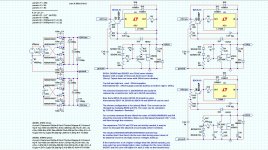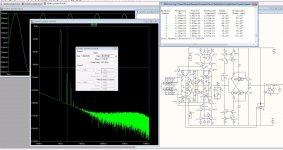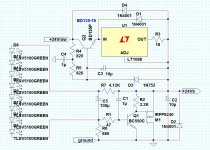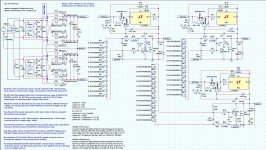Toroids are plenty.
Ringkern-Transformator SE-RKT offen - hifituning24.de
Some say that they couple more dirt into the circuit though.
Ringkern-Transformator SE-RKT offen - hifituning24.de
Some say that they couple more dirt into the circuit though.
Attached are may (currently final) research and power supply schemas with annotations. Also attached are the LTspice source files. Next thing for me (is build the real thing).
There are a positive and a negative supply and one variation that uses (almost) the same components for the negative supply as for the positive.
Also note that BC327 and BC337 transistors can be used to replace the BC550 and BC560.
And finaly, if you want more than 100 mA you should replace the single transistor (in the gyrator) with a Sziklai pair having a Rcb of about 100 Ohm. (more usage for your BC327 and BC337 transistors).
Can it be possible to avoid the zeners as Vref ? Maybe using a resistor over a ccs ?
That way the whole thing could be tuned by carefully choosing the resistor bypass cap 🙂
And I sometimes have noise issues with zeners (even 27v ones) and I guess 24v ones are the same. Super low noise zeners exist but.....
Attachments
Last edited:
Can it be possible to avoid the zeners as Vref ? Maybe using a resistor over a ccs ?
That way the whole thing could be tuned by carefully choosing the resistor bypass cap 🙂
And I sometimes have noise issues with zeners (even 27v ones) and I guess 24v ones are the same. Super low noise zeners exist but.....
Yes you can, like in the Salas shunt regulator.
Toroids are plenty.
Ringkern-Transformator SE-RKT offen - hifituning24.de
Some say that they couple more dirt into the circuit though.
My circuits always use toroid’s, and I always use a mu-metal box to separate the transformer from the rest of the box. I do like the dynamic behavior of the toroid although this is not the most important for small signal circuits.
Balanced RIAA preamp | Flickr - Photo Sharing!
Toroids are plenty.
Ringkern-Transformator SE-RKT offen - hifituning24.de
Some say that they couple more dirt into the circuit though.
The inter-winding capacitance is higher certainly. However, good filtering on the mains side and a solid inter winding screen go a long way to making the differences quite minimal.
R-cores are a great buzz word for the high end audio industry.
EI are a good compromise if using 2 boxes anyway. R-Core are better than the rest in all respects in my experience.
Can it be possible to avoid the zeners as Vref ? Maybe using a resistor over a ccs ?
That way the whole thing could be tuned by carefully choosing the resistor bypass cap 🙂
And I sometimes have noise issues with zeners (even 27v ones) and I guess 24v ones are the same. Super low noise zeners exist but.....
A string of LED's is also possible. Use a selected resistor (trimmer) for R7. The more LED's the better; I would say a minimum of five.
Attachments
Now were talking power-supply,,, the total consumption at 24V is app 100 mA each rail, so in total app 5W each channel
Now were talking power-supply,,, the total consumption at 24V is app 100 mA each rail, so in total app 5W each channel
If the circuit consumes 100mA then I need to recalculate the power supply for a current source of 150mA. Can you tell me what the maximum consumption of one mono channel will be (I guess we go for full dual mono).
A string of LED's is also possible. Use a selected resistor (trimmer) for R7. The more LED's the better; I would say a minimum of five.
These LED's (in the schema) are about 2Volts each (15Volts for the string of 8). The number of LED's also depends on the forward voltage of the LED. A total of, between, 20 and 22Volts will be ideal.
That is one mono-channel... 105 mA is drawn from each voltage source...
So we need 10 green lED's, a zener is app 20uV noise and an LED can be as low as 3-4uV, question is.. does that sum up or does is stay low due to the random spectra of the noise..??
So we need 10 green lED's, a zener is app 20uV noise and an LED can be as low as 3-4uV, question is.. does that sum up or does is stay low due to the random spectra of the noise..??
Last edited:
If the diode's noise is a voltage source, than it has to add, no?
Rüdiger
Non linearly though, because uncorrelated. You got to sum their squares and then sqrt that number.
I can see I remember a bit Wrong on the values for noise, Here there is a nice piece of work regarding noise in LED and Zeners, Made by Swedish DIY-Audio forum member Christer (Majstang, Krebs og surstrømming)
Given that the zener's may be a bit inconsistent, you may still like to select LED's for the reference. Using a string of 12 Yellow LED's would (Vrms added) generate about 1.3uV down to 1uV (being very optimistic) of noise (according to the list). I would say, we make place for the string of LED's and the builder can always stuff an zener diode in their place.
Last edited:
Frans, you are very pragmatic and i like that. Yes, we should make place for some Leds.
I personally have no problem with toroids either. I agree that the transformer should be in another compartment or in a separate box. This is the only way to avoid hum in a low lever circuit like that. Your preamp looks great inside. I like the copper pipes.
MiiB, that is what i was expecting. Gain goes up and so does distortion. -96dB is of cause excellent and the distortion distribution looks great. The only think i would like to see is when you go back from 50 Ohm degeneration to 20 Ohm and adjust the RIAA again for a gain of 61dB. If we get out the same distortion then the 20 Ohm degeneration would give somewhat less noise. I think after that experiment, we fix the parameters.
I personally have no problem with toroids either. I agree that the transformer should be in another compartment or in a separate box. This is the only way to avoid hum in a low lever circuit like that. Your preamp looks great inside. I like the copper pipes.
MiiB, that is what i was expecting. Gain goes up and so does distortion. -96dB is of cause excellent and the distortion distribution looks great. The only think i would like to see is when you go back from 50 Ohm degeneration to 20 Ohm and adjust the RIAA again for a gain of 61dB. If we get out the same distortion then the 20 Ohm degeneration would give somewhat less noise. I think after that experiment, we fix the parameters.
Frans, you are very pragmatic ...
Thanks 🙂 and yes I think so 🙂
Here a version with the filter, snubber resistors and LED's. The current has now been set to 150mA ( 105mA for the amplifier, 45mA to warm the planet).



